- Reviewing the New Fiction
- Looking Back . . .
- Who's Who?
- Style and Substance
- Reading Well
- The New Fiction Module Review
- Features First

Reading Modernism
Use the knowledge and skills you've gained during this module to complete this project.
The poet Ezra Pound uttered the rallying cry for the Modernist movement when he called upon writers to "Make it new!" In this module, you read and analyzed stories by 20th-century American writers who "made it new" in various ways. You also examined how these writers used new styles and themes to speak important truths about the challenges and changes of modern American life.

Suppose your town's public library system asks you to share your new knowledge of Modernist fiction. They are launching a Modern Fiction Book Club and inviting local teens and adults to meet online or at the library to discuss works of Modernist fiction like the stories you read for this module. The goal of the book club is to introduce readers to 20th-century American classics and to help them understand these works' role in shaping more contemporary American literature. Your assignment is to write a reader's guide for a 20th-century short story by a Modernist American author. The good news is that the library's program director is not picky about which author or work you choose as your focus. For the purpose of this assignment, though, you should select a story that you did not read for this module, although you may select one by one of the authors in the module.
Here's an example of the type of introduction and questions your reader's guide should include.
Reader's Guide for "The Black Ball" by Ralph Ellison
The main character of "The Black Ball" is a single father named John who works as a maintenance man at an apartment building, living in a small and shabby apartment over the garage. John's main concern is the well-being of his young son. He is careful to avoid offending the racist apartment building manager because John can't afford to lose his job. However, an unexpected visit from a stranger and a disturbing incident with the manager cause John to look more toward the future.
Sample Question: In the 1950s, discrimination against African Americans was a tragic fact of American life. By the end of the story, how does the narrator of "The Black Ball" decide to deal with the limits that racism imposes on him and his son?
You may select your story from the list below, or you may search online for other stories by the Modernist fiction writers you studied in this module: Ernest Hemingway, F. Scott Fitzgerald, Katherine Anne Porter, Carson McCullers, Ralph Ellison, Flannery O'Connor, or Shirley Jackson.
| "Babylon Revisited" by F. Scott Fitzgerald | |
| "The Far and the Near" by Thomas Wolfe | |
| "The Chrysanthemums" by John Steinbeck | |
| "Why I Live at the P.O." by Eudora Welty | |
| "The Secret Life of Walter Mitty" by James Thurber | |
| "Miriam" by Truman Capote |
Regardless of the story you choose to introduce, your reader's guide should accomplish these objectives:
- It should focus on a short story written by a Modernist author.
- It should address an audience of contemporary teen and adult readers who will read the story.
- Its introduction should accurately describe the main character and setting and summarize the story's conflict without giving away the ending.
- It should include at least four questions, with each question introduced by 1 to 3 sentences that provide a historical or literary context for it.
- It should help readers recognize and understand the Modernist aspects of the author's style or themes.
As you work on your reader's guide, review the assignment requirements frequently so that you don't leave out any important elements. Study the steps below carefully—they are based on the objectives above and contain more information about each of the requirements of the project.
| Choose one short story by one of the authors listed above. |
| Read the story. As you read, note the main characters, the setting, and the important events. To understand the setting and plot, you may need to read more about the historical context of the story, or what was happening in that particular place and time in history. Research the story's context online if necessary. Also take notes on Modernist aspects of the author's style or themes, based on what you have learned about Modernist fiction in this module. |
| Use your notes to write a brief introduction that describes the main character and the setting and summarizes the story's main conflict. Be sure to mention any significant elements of the story's historical context. |
| Write four or more discussion questions that focus on important stylistic elements and themes of the story. At least two questions should focus on Modernist elements of the story. |
| Write a brief introduction to each question to place it in context. For example, if you were writing about "The Black Ball" by Ralph Ellison, you might introduce a question about racial discrimination with a brief summary of the American civil rights movement. |
Your book club reader's guide will be evaluated according to the following rubric.
| Your assignment includes all of the required parts and each part meets the objectives for the project. | Your assignment includes all of the required parts, but not all parts meet the objectives for the project. | Some required parts are missing from your assignment. | |
| You have described the story's setting, main character and conflict in a compelling and accurate way without giving away the ending. | Some elements of your description and summary are inaccurate or misleading, or you have given away the ending of the story. | Your description and summary of the story are unhelpful to the reader of your guide because they are inaccurate and misleading. | |
| You have written at least four questions about the story that help readers analyze the Modernist aspects of the author's style and themes. | Some of your questions do not focus on Modernist-era styles, subject matter, or themes. | None of your questions focus on relevant Modernist aspects of the story. | |
| Each of your discussion questions is preceded by 1-3 sentences that provide intriguing historical or literary context. | Some of your introductory sentences fail to place the question in its historical or literary context. | Your introductory sentences consistently fail to place the story in its historical or literary context. |

Everything You Need to Teach Literary Modernism in High School English
- Instructional and Assessment Strategies , Reading Instruction
In my junior English class, we spend a lot of time focused on American literary periods. Literary modernism is one of the trickiest to define. In academic circles, there is great debate about what “modernism” even means. However, to keep that confusion out of the classroom, I focus on a few specific characteristics of modernism.
To guide our study of American literary modernism, we focus on a few key questions:
- What is the historical setting of the text?
- How does literature reflect the historical context in which it was written?
- In what way would the text be different if it had been written in a different period?
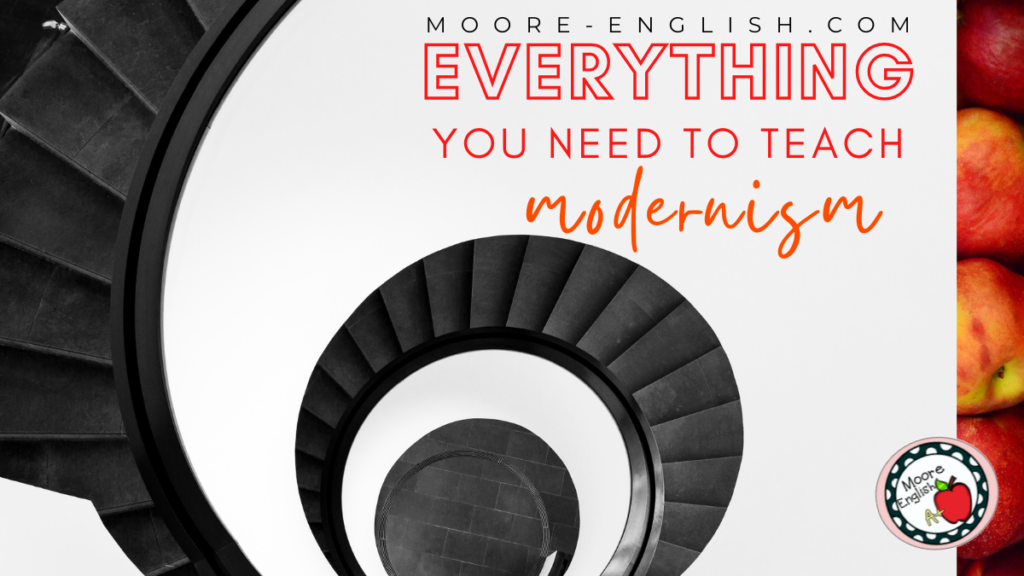
This post this post may contain affiliate links . Please read the Terms of Use .
Introducing Modernism
By the time my juniors reach modernism, they have studied the American Enlightenment , Romanticism , Regionalism , and Realism .
Based on the time period in which modernism begins, I ask students what historical event likely begins this period. For the most part, they can name World War I. Then, we skip to the end of this time period and see that modernism ends with World War II. Based on these two bookends, I ask students to think-pair-share how they think that much war and trauma will affect American literature.
Then, I write students’ brainstorm on the board before we turn our attention to “ The Death of the Ball Turret Gunner ” by Randall Jarrell (read it here ). I start with this poem because of its brevity, clear “plot,” and evident main idea. As a class, we read and annotate the poem. Then, we match the poem to students’ brainstorm. Which elements from students’ brainstorm appear in the poem? Which do not? What, if anything, do we need to add or remove from the brainstorm?
From here, I introduce this acronym to help students remember the elements of modernism. As we go along, we match the elements of the acronym to students’ brainstorm. Then, we look for each element of modernism in the poem.
To continue our study of modernism, we focus on war poetry. This collection of poems helps students build on their reading of “The Death of the Ball Turret Gunner.” It also helps students understand how the trauma of war affected and shaped modernist literature. War poetry also features isolated and alienated characters who are often rejecting tradition. Further, the psychological realism of war poetry helps students engage with the text.
- First, “ Anthem for Doomed Youth ” by Wilfred Owen does a good job expanding on Randall Jarrell’s work. This is the second poem we read because it has a clear perspective and voice. A lot of the poetry we read deals with the effects of trauma from World War I. Read it here .
- Similarly, “ Grass ” by Carl Sandburg focuses on the effects of war. This is a good upward scaffold because this poem has a more experimental structure. Certainly, the speaker is quite different from the speaker’s of Jarrell and Owen’s poems. Read it here .
Grab these poems plus four more in Synthesis Bundle #5: War Poems !
Increasing Text Complexity
In part, poetry is helpful because it’s easiest to see how modernist authors experiment with form in poems. The brevity of poetry also means that we can encounter more representations of modernism in quick succession. However, not all modern poetry is war poetry, and some poems are more complex than others. As our study of modernism continues, it’s important to continually scaffold students to more challenging texts.
- To begin “ i carry your heart with me (i carry it in) ” by E.E. Cummings is a good upward scaffold. From the start, Cummings’ structural choices instantly catch students’ attention. This poem is a clear example of how modern writers experiment with form and structure . However, it’s tonally very different from other modernist texts on this list, so it helps students see the diversity of modernism. Read it here .
- “ The Unknown Citizen ” by W.H. Auden introduces students to satire. The tone of this poem is so wildly different from previous poems on this list, and it uses a third-person narrator to such a jarring effect. Read it here .
- Similarly, “ Musee des Beaux Arts ” by W.H. Auden gives the modernist treatment to the story of Icarus . This poem really lends itself to the question: How would this moment be different if it were written in a different literary period? Read it here .
Find most of these texts in my Modernism Bundle !
The Great Gatsby
In terms of longer works and novels, The Great Gatsby is a quintessential piece of American modernism. To help students evaluate the text through its historical context , students may need to complete additional research about what America was like in the 1920s. To help students think through the text, consider the following activities:
- Engaging students with this free anticipation guide can help students to begin thinking about the issues involved in The Great Gatsby .
- Writing journals about the novel can help students evaluate the text’s modernism while also helping students make connections with the text. Check out my favorite journals !
- Keeping a symbol log can help students evaluate how the settings and symbols in the novel help Fitzgerald create class commentary.
- Using task cards can help students evaluate the text as a piece of modernism, but task cards can also help students apply literary criticism to the text.
Further Reading
Since literary periods play an important part in my junior American literature class, I’ve written a lot about the subject!
- How To Engage Students In Studying The American Enlightenment
- American Enlightenment Pacing Guide and Unit Bundle
- American Romanticism Unit Bundle and Resources
- Everything You Need to Teach Romanticism
- Everything You Need to Teach Regionalism
- American Literary Movements
- Regionalism Collection
- Modernism Collection
- Post-Modernism
- Realism Notes

Read these posts next...

Jazz Up a Boring Textbook Lesson with These 6 Easy Ideas

13 Spooky Season Stories for Your Classroom Library

My 4 Favorite Differentiation Strategies for High School
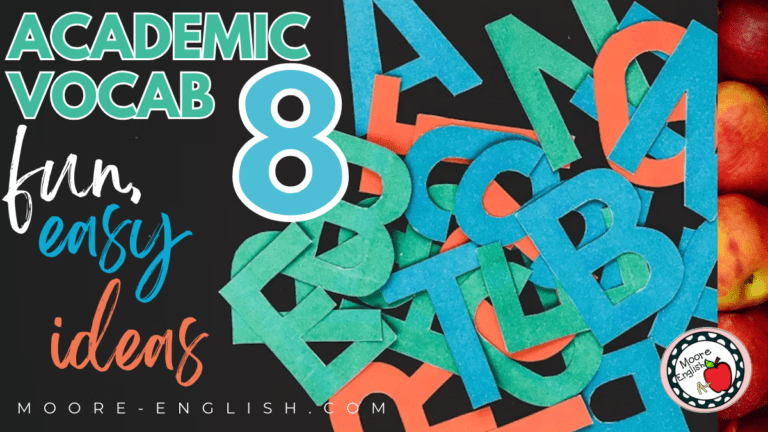
Make Academic Vocabulary Fun with These 8 Effortless Ideas

Let's Stay in Touch
Join Moore English

Browse Course Material
Course info.
- Dr. William Donaldson
Departments
As taught in, learning resource types, bestsellers: out for the count, literary modernism.
Bradbury, Malcom and James McFarlane. Modernism: A Guide to European Literature 1890–1930 . Penguin, 1976. ISBN: 9780140138320.
Many commentators have treated Modernism as a consequence of cultural catastrophe, a violent breach with the past in terms of both content and style; others have seen it as a logical development of what went before. Since a number of writers on this course consciously reflected the Modernist style, it may be useful if we know a little of what this might mean. See how many of the following features you can trace in the texts that follow:
Bradbury and McFarlane’s introductory essay “Name and Nature of Modernism” speaks of “overwhelming dislocations, cataclysmic upheavals of culture, fundamental convulsions of the creative human spirit that seem to topple even the most solid and substantial of our beliefs and assumptions, leave great areas of the past in ruins, question an entire civilization or culture, and stimulate frenzied rebuilding” (pp. 19–20).
The word Modern is elusive and difficult of definition, and also very awkward for describing what is now a historical period. It covers a considerable multiplicity of styles. “The term has been used to cover a wide variety of movements subversive of the realist or the romantic impulse and disposed towards abstraction (Impressionism, Post-Impressionism, Expressionism, Cubism, Futurism, Symbolism, Imagism, Vorticism, Dadaism, Surrealism); but these are not…all movements of one kind, and some are radical reactions against others” (p. 23).
Bradbury and McFarlane see the unifying feature of the various branches of the Modernist enterprise as a case of manner rather than content whose distinguishing qualities are abstraction and highly conscious artifice, taking us behind familiar reality, breaking away from familiar functions of language and conventions of form. Definitions of “the real” are important because the common strand in modernist art is somehow to become independent of it or to transcend it. Qualities include:
- sophistication
- introversion (i.e. intense self-absorption on the part of the writer)
- technical display
Its characteristic forms are:
- anti-representationalism in painting
- atonalism in music
- verse libre in poetry
- stream-of-consciousness narrative in the novel.
- a sensing of, an exploitation of, a celebration of, cultural disaster, an “immense panorama of futility and anarchy” (p. 27).
Bradbury and Mcfarlane identify amongst the leading Modernist writers Yeats, Joyce, Eliot, Lawrence, Proust, Valery, Gide, Mann, Rilke, Kafka, and Virginia Woolf. Dating is problematic but most accounts concentrate on the first thirty or so years of the 20th century, seeing Modernism’s “annus mirabilis” as 1922, the year of Ulysses and The Waste Land , of Brecht’s Baal , of Lawrence’s Aaron’s Rod , Woolf’s Jacob’s Room , Proust’s Sodome et Gomorrhe, and Eugene O’Neill’s Anna Christie . Nihilism, alienation, and angst are generally seen as the classic attributes of Modernist writers and Modernist artworks. A reaction against 19th-century Positivism introduced a corresponding interest in irrational and unconscious forces in thinkers like Sorel, Bergson, and Pareto.
Modernism in most countries was an extraordinary compound of the futuristic and the nihilistic, the revolutionary and the conservative [the politics of some leading Modernist artists was extremely reactionary], the naturalistic and the symbolistic, the romantic and the classical. It was a celebration of a technological age and a condemnation of it… in most countries the fermenting decade was the eighteen nineties. (p. 46)
Richard Sheppard’s essay, “German Expressionism”, pp. 274–291, traces its foundation to the second decade of the 20th century. Destructive in intent, and directed against the comfortable certainties of bourgeois platitude in art: “conviction that the institutions of industrial capitalism were maiming and distorting human nature by developing the intellect and the will in the service of material production and neglecting the spirit, feelings and imagination…Paul Fechter [writing in 1920 in Der Expressionismus ] spoke about’the shift of emphasis from inner to outer matters is victorious all along the line’” (p. 276). In his essay “Dada and Surrealism”, pp. 292–308, Robert Short says of this group “..they disputed whether, in the light of new knowledge about man’s psychology and the nature of the universe which was his environment, the production of works of art or literature was any longer feasible, morally justifiable or socially worthwhile” (p. 301).
“The Language of Modernist Fiction: Metaphor and Metonymy” by David Lodge, pp. 481–496, itemises the qualities which mark modernist writing:
First, it is experimental or innovatory in form, exhibiting marked deviations from existing modes of discourse, literary and non-literary. Next, it is much concerned with consciousness, and also with the subconscious or unconscious workings of the human mind…Lastly, modern fiction eschews the straight chronological ordering of its material, and the use of a reliable, omniscient and intrusive narrator. It employs, instead, either a single, limited point of view, or multiple viewpoints, all more or less limited and fallible; and it tends toward a complex or fluid handling of time, involving much cross-reference back and forward across the temporal span of the action. (p. 482)

You are leaving MIT OpenCourseWare
Modernism Assignment Directions
- Arts & Humanities
Beyond the Boundaries: The Bold World of Modernist Literature
Table of contents
- 1 Modernism Definition
- 2.1 Rejection of Traditional Forms and Conventions
- 2.2 Experimentation with Narrative Structure and Style
- 2.3 Focus on Subjective Experiences and Interiority
- 2.4 Fragmentation and Non-linear Storytelling
- 2.5 Emphasis on Individualism and Self-expression
- 3.1 Alienation and Disillusionment
- 3.2 Loss of Faith and Existential Angst
- 3.3 Stream of Consciousness and Inner Thoughts
- 3.4 Ambiguity and Uncertainty
- 3.5 Critique of Societal Norms and Values
- 4 Modernist Writers in the Literary Movement
- 5 Criticisms and Challenges to Modernism
- 6 Impact of Modernism
- 7 Bottom Line
The epoch of modernism, a transformative movement spanning the late 1800s to the early 1900s, is a remarkable chapter in the book of literary history. It sparked a creative revolution that forever changed the face of literature, ripping up the rulebook and breathing life into a new generation of storytelling.
Unafraid to shatter conventions, modernist works delved fearlessly into the depths of human nature, reflecting a world in flux and quickening under the pulse of change. This article sets out to navigate the vibrant tapestry of modernist literature. It will explore the hallmarks that set it apart, the recurring themes echoing through its works, and the luminary writers who dared to reinvent the literary wheel.
Moreover, we’ll deeply dive into this groundbreaking movement’s challenges and contemplate its lasting influence. This influence ripples through the literary landscape even today, echoing across the years.
Modernism Definition
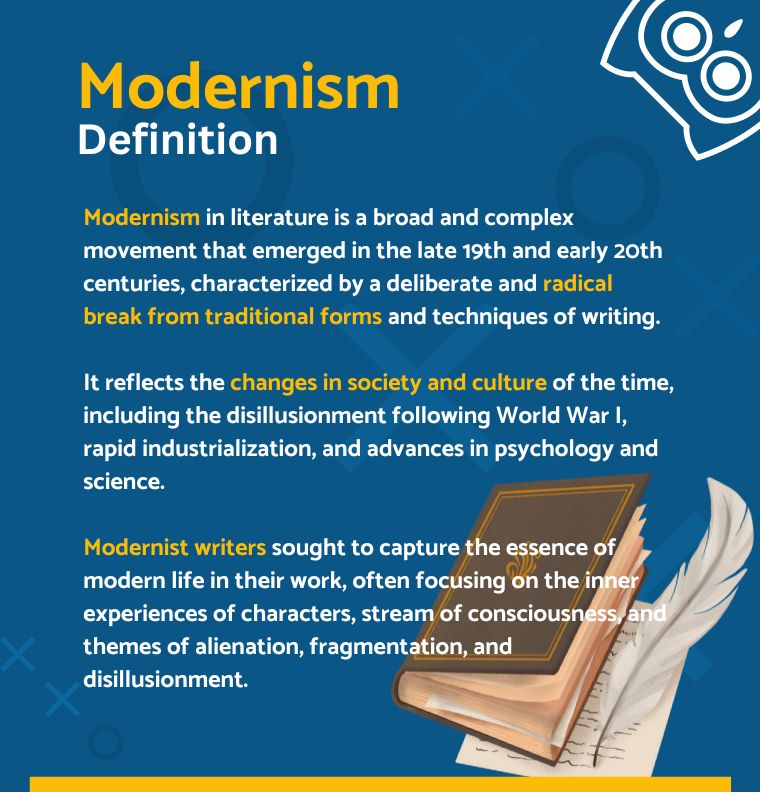
Modernism in literature signifies a dynamic cultural shift that took root in the late 19th and early 20th centuries. This wave of change was a direct rebuttal to the established norms of Victorian literature and the romanticized vision of nature, favoring instead a more disjointed and subjective depiction of human nature and experience.
The inception of modernism didn’t occur in isolation; it was inseparably knotted with the epoch-making transformations of its era. The tremors of World War I had fundamentally shaken the world, and, coupled with rampant urbanization and the surge of industrialism, they started a tectonic shift in societal structures and consciousness.
These pivotal changes underpinned the collective experience, creating overwhelming disillusionment and alienation. This societal disenchantment served as the perfect crucible for the emergence of modernism in literature. The movement encapsulated this disillusionment and estrangement, elegantly mirroring the time’s fragmented reality and subjective human experience.
The term modernism was more than just a literary shift; Modernism was a seismograph, recording the societal shifts and human sentiments of an era of turbulent change. So asking, “what is modernist literature?” isn’t enough as a question to understand the concept. It involves many factors, such as modernist techniques, characteristics of literary modernism.
Need help with essay writing? Get your paper written by a professional writer Get Help Reviews.io 4.9/5

Characteristics of Modernism in Literature
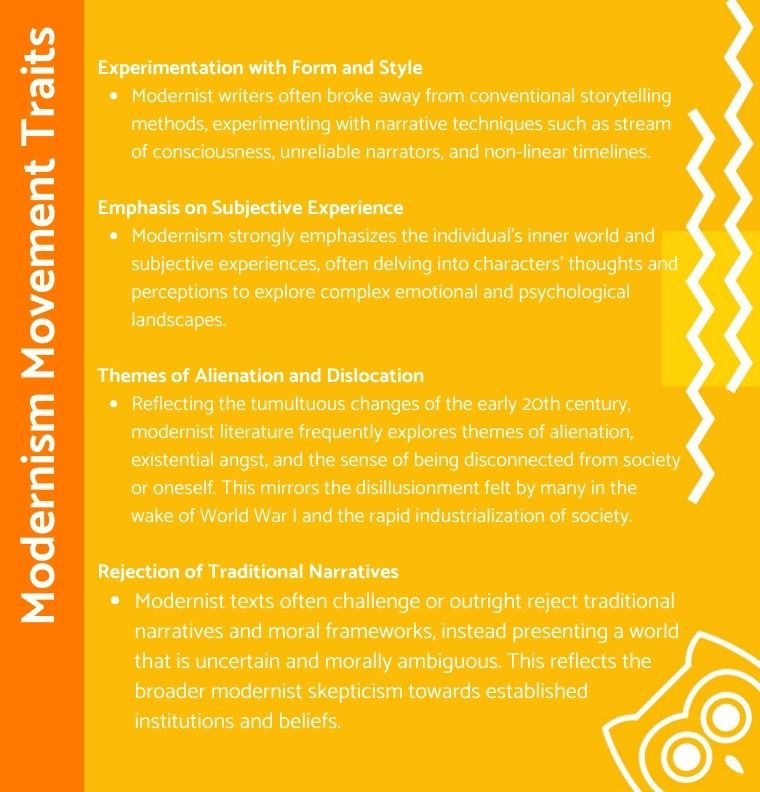
As a revolutionary movement, Modernist works introduced various novel techniques and thematic concerns that challenged traditional literary norms. The following are some of the most significant characteristics of the modernist period that define this influential period in literary history.
Rejection of Traditional Forms and Conventions
Modernist literature marked a revolutionary, conscious break from conventional literary methods. It vehemently dismissed the structured composition, ethical absolutes, and elaborate language that were hallmarks of Victorian literature. Modernist authors chose to mirror their age’s mess, fragmented reality, purposefully disrupting and upending entrenched norms. This shift wasn’t merely about moving away from the past but a purposeful leap into the uncharted territories of literary expression.
Experimentation with Narrative Structure and Style
One of the defining features of literary modernism is its inventive manipulation of form. Many writers fearlessly experimented with stream-of-consciousness narrative, a technique that attempts to simulate human thoughts’ free-flowing and non-linear nature. They also embraced innovative structures, such as fragmented narratives and polyphonic perspectives, which magnified their works’ intricacy and depth.
Focus on Subjective Experiences and Interiority
Literary modernism bore a significant focus on the internal world of characters. It dismissed the external, observable world in favor of the subjective and introspective, putting a magnifying glass on characters’ perceptions and mental states in the short story rather than prioritizing the storyline. This shift in focus emphasized the complexity of individual perception as authors sought to navigate the labyrinth of the human mind.
Fragmentation and Non-linear Storytelling
Modernist works often eschew the orderly progression of linear narratives, reflecting the fragmented, disjointed reality of the early modernists’ era instead. The storyline is frequently fractured, disrupted, or intentionally made challenging to follow. This narrative style underscores the themes of uncertainty and dislocation pervasive during the first modernist period, skillfully translating societal disruption into a narrative form.
Emphasis on Individualism and Self-expression
The individual’s experience takes center stage in many modernist writers’ works. In short stories, writers amplified the characters’ autonomy and self-expression, frequently set against restrictive societal norms or cataclysmic events. This emphasis on individual experience was a narrative choice and a bold statement on the value and complexity of personal perspectives in a rapidly changing world.
Literary modernism represented a daring shift in how writers perceived the world and human experience. Its innovative narrative techniques and focus on the subjective experience offered a fresh lens to examine reality, one that continues to shape and influence literature today.
Modernist literature was more than just a movement; it was a profound, deeply felt response to an era of enormous change and upheaval. As outlined above, modernism’s five traits and characteristics can only begin to touch upon the rich, multifaceted world of literary movements – a world that continues to inspire and provoke us to this day.
Major Themes in Modernist Literature
Modernist literature, with its innovative techniques, literary devices, and unconventional narratives, is marked by several recurrent themes reflecting its time’s societal transformations. Exploring these key modernist themes also offers a deeper understanding of the modernist movement’s spirit and lasting impact on literary history.
Alienation and Disillusionment
A dominating theme in literary modernism is the deep sense of alienation and disillusionment. This sentiment mirrors the rough societal shift and profound distrust in institutions that marked the era. Characters in modernist works often grapple with feelings of detachment and rootlessness, reflecting a sense of being adrift in a society that seems increasingly remote and impersonal.
They are typically dissatisfied with the societal norms and structures, caught in a world that has moved away from the traditional values they once held dear. This results in an acute sense of isolation as they try to find meaning and purpose in an evolving world that feels strange and disturbing.
Loss of Faith and Existential Angst
Another recurring theme in modernist literature is the loss of faith and the resulting existential angst. Characters often wrestle with a crisis of belief, which could be religious, ideological, or both.
This crisis leads many modernists and writers to deep existential angst, a fear of the lack of defined purpose or meaning in life. This existential dread is often portrayed through characters questioning their existence, societal roles, and the larger purpose of life and human existence. They grapple with profound uncertainties, their disillusionment leading to a rejection of previously accepted beliefs and values.
Stream of Consciousness and Inner Thoughts
The stream-of-consciousness narrative technique, widely employed by modernist writers, was an innovative attempt to depict the uninterrupted, often chaotic, flow of characters’ inner thoughts and feelings.
This style provided a more intimate peek into the mental landscape of characters, offering readers a sense of the complexities and contradictions that often lie beneath surface behavior. The intricate interplay of thoughts, memories, feelings, and reflections helped create more human, flawed, and relatable characters.
Ambiguity and Uncertainty
Modernist literature is characterized by intentional ambiguity and uncertainty. These works often lack a clear moral center, mirroring the perceived absence of absolute truth in a rapidly evolving society.
They challenge the reader to navigate the moral and interpretative ambiguity, offering multiple perspectives, fragmented narratives, and open-ended conclusions. This characteristic of modernist literature underscores the inherent uncertainty of life, reflecting the complex, multi-layered realities of a changing world.
Critique of Societal Norms and Values
Modernist literature didn’t shy away from critiquing its time’s dominant societal norms and values. The works often challenged ingrained conventions related to gender roles, class hierarchies, morality, and other societal structures. Modernist authors boldly deconstructed traditional notions and presented alternate perspectives, forcing readers to question and rethink long-held beliefs.
They scrutinized societal norms’ inequities, hypocrisies, and underbelly, inspiring introspection and debate about the essence of morality, the fluidity of gender roles, and the societal constraints that limit individual freedom. This critique made modernist literature a powerful platform for social commentary, mirroring and challenging the world it emerged from.

Modernist Writers in the Literary Movement
As we journey through the intricate landscape of the modernist literary movement, certain names shine brightly, their contributions serving as pillars of this transformative epoch in English literature.
Let us delve into the short stories and profiles of these influential modernist poets and writers, each leaving an indelible mark on literature through their unique and groundbreaking works.
- James Joyce: Emerging from Ireland’s verdant literary landscape, Joyce commands a monumental stature among the 20th-century literati. His seminal oeuvre, with masterpieces like “Ulysses” and “Finnegans Wake,” stand as powerful testaments to his groundbreaking contributions. These works pushed the boundaries of conventional storytelling with their intricate narrative structures and pioneering use of the stream-of-consciousness technique. Joyce’s daring narrative approach has challenged readers and deeply influenced subsequent generations of writers.
- Virginia Woolf: A towering figure in the modernist canon, Woolf revolutionized narrative structure by delving into the inner workings of her characters. Her signature novels, “Mrs. Dalloway” and “To the Lighthouse,” present an introspective examination of gender, psychology, and perception. Woolf’s writing, celebrated for its lyricism and experimental form, echoes the shifting consciousness of the modern world.
- T.S. Eliot: Hailing from American roots yet flourishing on British soil, Eliot is a formidable figure in modernist poetry. His magnum opus, “The Waste Land,” is viewed as a defining piece of the modernist era. This seminal work is a mosaic of fragmented narratives interspersed with allusions to various cultural and literary texts, reflecting the disjointed reality of post-war society.
- Ernest Hemingway: Known for his stark minimalism, Hemingway’s prose presents a radical departure from the elaborate Victorian tradition. Novels like “The Sun Also Rises” and “A Farewell to Arms” emphasize dialogue and action over ornate description, encapsulating Hemingway’s iceberg theory: stating only the surface, leaving the depths to be inferred by the reader.
- Scott Fitzgerald: Celebrated for encapsulating the zeitgeist of the Jazz Age, Fitzgerald’s paramount work, “The Great Gatsby,” emerges as a shining beacon of modernist literature. His vivid portrayal of decadence, disillusionment, and the pursuit of the American Dream resonates with the collective experiences of his generation.
- Franz Kafka: This Czech author’s enigmatic and introspective oeuvre, featuring profound works like “The Metamorphosis” and “The Trial,” place him firmly among the giants of modernist literature. Kafka’s literature, riddled with existential dread, guilt, and the absurd, mirrors the existential crisis of the modern individual.
- Marcel Proust: Proust’s monumental magnum opus, “In Search of Lost Time,” is famed for its sprawling introspection and deep exploration of memory and perception. This innovative narrative approach, coupled with his lucid, sensual prose, provides an immersive reading experience that encapsulates the essence of modernist literature.
- William Faulkner: Faulkner’s novels, notably “The Sound and the Fury,” are celebrated for their daring narrative structures, complex themes, and rich character development. His unique approach to storytelling, encompassing multiple perspectives and non-linear timelines, exemplifies the modernist exploration of consciousness and reality.
- D.H. Lawrence: Considered modernist, Lawrence broke societal norms by candidly exploring human instincts and sexuality in works such as “Lady Chatterley’s Lover.” His unapologetic examination of human desire placed him at the center of controversy and affirmed his place in the modernist canon.
- Ezra Pound: As an influential figure in modernist poetry, Pound’s work, including “The Cantos,” and his vigorous advocacy of free verse and imagism, left a lasting imprint on 20th-century literature. His radical experimentalism embodied the modernist spirit of innovation and transformation, influencing a generation of modernist poets.
Criticisms and Challenges to Modernism
Although modernism has profoundly influenced the literary landscape, it has not been without its detractors. A primary line of criticism centers on its experimental techniques and literary style, which, while innovative, can render works challenging and sometimes inaccessible to many readers. The complexity and obscurity of modernist writing, typified by labyrinthine narratives and stream-of-consciousness techniques, can distance the less seasoned reader’s imagination, making these literary masterpieces appear intimidating and abstruse.
Another critique of modernism targets its emphasis on individualism and introspection, which some perceive as self-indulgent or even elitist. Modernist literature often grapples with the personal psyche’s depths, frequently prioritizing the individual perspective and subjective reality over broader societal commentary. This inward focus has led critics to argue that the movement’s pursuit of subjective truth tends to neglect broader social dynamics, rendering it insular and somewhat self-absorbed.
There is also criticism of modernism’s Western-centric focus, with detractors arguing that it frequently sidelines the voices and experiences of marginalized communities. While many aspects of modernism were indeed a response to the rapid societal changes occurring predominantly in Western societies, its often narrow cultural lens has been questioned for its potential exclusion of diverse global perspectives. Critics argue that this Eurocentric slant risks silencing the narratives of non-Western or marginalized communities, thereby limiting the scope and inclusivity of the movement.
The advent of postmodernism in the mid-20th century presented a direct challenge to the tenets of modernism. Postmodernists rejected the grand narratives and singular truths upheld by many modernist writers, emphasizing reality’s relative and constructed nature instead. Postmodernism posits that truth is not a fixed or universal characteristic of modernism but rather subjective and multifaceted, influenced by a myriad of cultural, historical, and individual factors.
Finally, some critics have argued that the modernist insistence on breaking with the past and constantly innovating can lead to a sense of discontinuity and disconnection. They argue that this relentless drive towards the new can overlook the importance of literary traditions and the wisdom they offer.
While literary modernist characteristics were a transformative force that redefined the literary world, its legacy is a complex tapestry of innovation and controversy. The challenges and criticisms it has faced contribute to the ongoing dialogue about its role and impact, ensuring that literary modernism itself remains a vibrant subject of literary exploration.
Impact of Modernism
Modernism’s seismic impact on literature and the arts transcends time and geography, leaving an indelible mark that continues to resonate today. The movement challenged traditional forms, broke conventional norms, and carved out a fresh epoch of creative freedom. This audacious spirit of experimentation that typified the characteristics and themes of modernism in literature has forever broadened the scope of artistic expression and redefined the boundaries of possibility.
This bold revolt against established traditions manifested in dismantling linear narrative structures, moving towards psychological introspection, and exploring fragmented perspectives. Modernist artists like James Joyce and Virginia Woolf introduced the world to the stream-of-consciousness technique, giving readers unprecedented access to their characters’ internal landscapes. This introspective shift fostered a deeper exploration of human consciousness, a thematic thread that continues to weave through contemporary literature.
Modernist visual arts, influenced by the same zeitgeist, also transformed radically. Painters like Picasso and Kandinsky disrupted the convention of realistic representation, veering towards abstraction and expressionism. This audacious departure from reality mirrored the modernist literary ethos, challenging the audience’s perceptions and pushing the boundaries of their respective mediums.
In the architectural realm, modernism championed functionality features of modernism and simplicity over ornate decoration. Iconic structures such as Le Corbusier’s Villa Savoye and Mies van der Rohe’s Barcelona Pavilion embody the modernist principles of form following function, a design philosophy still influential in contemporary architecture.
In music, modernist composers like Stravinsky and Schoenberg sought to redefine the musical language, experimenting with atonality and complex rhythms. This spirit of reinvention echoed the broader modernist commitment to challenging established norms.
In essence, the modernist movement reshaped the creative world, introducing a new lexicon of artistic expression. Its legacy persists, with its influence palpable in contemporary works across multiple disciplines. From narrative experimentation in literature to abstract explorations in visual art, from the pared-down aesthetic characteristics of modernism in a modernist work in architecture to innovative musical compositions, modernism’s echoes continue reverberating through the annals of creative expression.
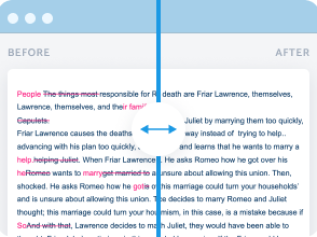
Bottom Line
In essence, the elements of modernism in literature force revolutionized literature. The movement ushered in a new era of deep psychological exploration, innovation in narrative techniques, and a significant rupture from traditional literary norms. While the movement is not devoid of criticism, its lasting influence inspires generations of writers, shaping and informing our understanding of the human experience, particularly in times of change, uncertainty, and flux.
Despite its complexities and the critiques it garnered, the modernist literary movement’s impact on the literary world remains undeniable. From stream-of-consciousness narratives to the subjective portrayal of reality, the footprints of the modernist literary movement can be traced through the corridors of contemporary literature, signifying its timeless and universal appeal.
Readers also enjoyed

WHY WAIT? PLACE AN ORDER RIGHT NOW!
Just fill out the form, press the button, and have no worries!
We use cookies to give you the best experience possible. By continuing we’ll assume you board with our cookie policy.

IMAGES
COMMENTS
The goal of the book club is to introduce readers to 20th-century American classics and to help them understand these works' role in shaping more contemporary American literature. Your assignment is to write a reader's guide for a 20th-century short story by a Modernist American author.
Everything You Need to Teach Literary Modernism in High School English. Instructional and Assessment Strategies, Reading Instruction. In my junior English class, we spend a lot of time focused on American literary periods. Literary modernism is one of the trickiest to define. In academic circles, there is great debate about what “modernism ...
Modernism in “The Old Man at the Bridge” Answer Key. Directions: As you read “The Old Man at the Bridge,” identify elements of Modernism. In the left column, write the specific passage that exemplifies Modernism. In the middle column, write which aspect of Modernism it exemplifies.
Reading guide for Malcom Bradbury and James McFarlane's Modernism: A Guide to European Literature 1890–1930.
Modernism was a literary movement that lasted from the late nineteenth century to around the mid-twentieth century, and encapsulated a series of burgeoning writing techniques that influenced the course of literary history.
Reading Modernism Assignment Reader's Guide for a 20th-Century Short Story Directions: Start by picking a 20th-century short story to write your reader's guide on.
Regardless of the story you choose to introduce, your reader's guide should accomplish these objectives: It should focus on a short story written by a Modernist author. It should address an audience of contemporary teen and adult readers who will read the story.
Embark on an in-depth investigation of Modernism, a significant literary movement that revolutionized the literary world. Explore how it defied traditional norms by incorporating fragmented storylines and delving into profound psychological insights to effectively depict the intricate nature of contemporary existence.
Modernism, in its broadest definition, is modern thought, character, or practice. More specifically, the term describes the modernist movement, its set of cultural tendencies and array of associated cultural movements, originally arising from wide-scale and far-reaching changes to Western society in the late 19th and early 20th centuries.
View Reading Modernism Assignment .pdf from ENGLISH 11 at Corner Canyon High School. Cade Ewell The story I read was The Far and the Near by Thomas Wolfe. This story covers the experiences of a train.